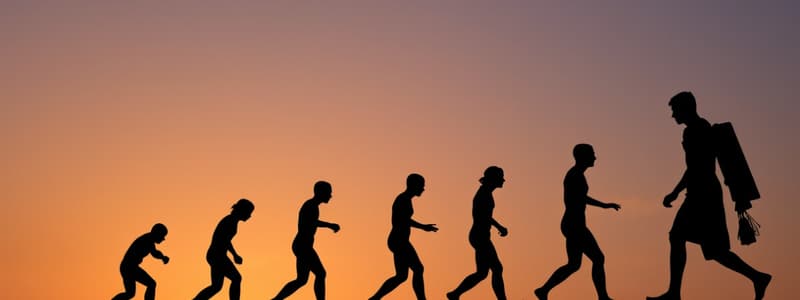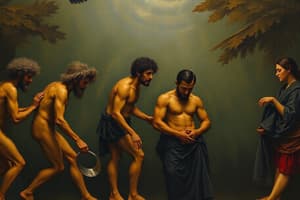Podcast
Questions and Answers
What are the important principles of natural selection as proposed by Darwin?
What are the important principles of natural selection as proposed by Darwin?
- Variation, heritability, and reproductive success (correct)
- Species variation, genetic drift, and survival
- Environmental changes, competition, and extinction
- Adaptation, mutation, and survival of the fittest
Cultural evolution refers to changes in the biological aspects of a species.
Cultural evolution refers to changes in the biological aspects of a species.
False (B)
Who is the famous naturalist known for developing the theory of biological evolution?
Who is the famous naturalist known for developing the theory of biological evolution?
Charles Darwin
Natural selection favors organisms that are better adapted to their ______.
Natural selection favors organisms that are better adapted to their ______.
Match the following aspects of evolution to their definitions:
Match the following aspects of evolution to their definitions:
What factors influence cultural evolution?
What factors influence cultural evolution?
Bipedalism refers to the ability of humans to walk on all fours.
Bipedalism refers to the ability of humans to walk on all fours.
What is one example of how scientists study cultural evolution?
What is one example of how scientists study cultural evolution?
What is the primary mechanism for biological evolution according to Darwinian theory?
What is the primary mechanism for biological evolution according to Darwinian theory?
Cultural evolution refers to changes and adaptations in the genetics of a species.
Cultural evolution refers to changes and adaptations in the genetics of a species.
What is biological evolution?
What is biological evolution?
The process of adaptation in humans to various climates demonstrates significant __________ evolution.
The process of adaptation in humans to various climates demonstrates significant __________ evolution.
Match the following terms with their definitions:
Match the following terms with their definitions:
Which of the following best describes the role of museums in studying human evolution?
Which of the following best describes the role of museums in studying human evolution?
Biological evolution only occurs through intentional changes made by species.
Biological evolution only occurs through intentional changes made by species.
How long ago did the first modern-looking humans appear according to the module?
How long ago did the first modern-looking humans appear according to the module?
What was the estimated brain size of Homo erectus?
What was the estimated brain size of Homo erectus?
Homo sapiens neanderthelensis were primarily herbivorous.
Homo sapiens neanderthelensis were primarily herbivorous.
What significant innovation did Homo erectus introduce that aided in food preparation?
What significant innovation did Homo erectus introduce that aided in food preparation?
Homo erectus is believed to be the first Homo species to use _______ for communication.
Homo erectus is believed to be the first Homo species to use _______ for communication.
Which characteristic is NOT associated with Homo sapiens sapiens?
Which characteristic is NOT associated with Homo sapiens sapiens?
Which early Homo group was known for making complex tools for digging and cutting?
Which early Homo group was known for making complex tools for digging and cutting?
Match the following Homo groups with their characteristics:
Match the following Homo groups with their characteristics:
The fossils of _______ were found in Trinil, Java Indonesia, in 1811.
The fossils of _______ were found in Trinil, Java Indonesia, in 1811.
Flashcards are hidden until you start studying
Study Notes
Biological and Cultural Evolution
- Biological evolution involves physical changes in humans, including bone structure, brain size, and dentition over generations.
- Key aspect of biological evolution is the study of bipedalism, which refers to walking upright on two feet.
- Cultural evolution denotes the progression of human societies from simple to complex cultures due to adaptations to challenges such as climate and population growth.
- Artifacts and tools are reflective of cultural evolution and are studied to understand changes in human lifestyles.
Charles Darwin and Darwinism
- Charles Darwin introduced the theory of evolution, which states that species develop through natural selection and inherited variations.
- Three principles of natural selection:
- Variation among individuals.
- Heritability of traits.
- Reproductive success of better-adapted organisms.
- Darwin posited that species better suited to their environments survive and propagate their traits through generations.
Key Concepts
- Evolution: Change in species characteristics over generations, driven by natural selection.
- Dentition: Arrangement and condition of teeth in a species.
- Progeny: Offspring or descendants of a biological entity.
- Bipedal: Walking using two legs.
- Genus: Biological classification ranking between family and species, always capitalized in naming.
Evolution of Early Humans
- Biological evolution includes genetic modifications in populations across generations.
- Homo erectus:
- Lived from 1.8 million to 300,000 years ago.
- Average brain size approx. 1000 cc; height about five feet.
- Known for advanced tool-making including hand axes and usage of fire.
- First to develop spoken language, facilitating cooperation and social interaction.
- Engagement in religious rituals, with evidence of burial practices.
- Significant fossils found in Java (Java man) and China (Peking man).
Homo Sapiens
-
Homo sapiens neanderthelensis:
- Larger brain size than modern humans; strong and muscular.
- Carnivorous diet with tools reflecting hunting lifestyle.
- Resided in more comfortable caves, exhibiting social living.
-
Homo sapiens sapiens:
- Modern humans characterized by reduced size and brain size (about 1300 cc).
- Evolved features include smaller jaws, rounded skulls, and development of art and complex tools.
- Cro-Magnon considered early Homo sapiens dispersed across Europe, Australia, and the Americas with diverse diets and advanced thinking capabilities.
Studying That Suits You
Use AI to generate personalized quizzes and flashcards to suit your learning preferences.




